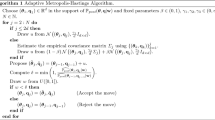Abstract
A method is developed to locate an unknown emission source. Theproposed method is based on the assumption that the GaussianPlume model (GPM) completely describes the dispersion ofpollutants in atmospheric air. A concept called `Equipotentialpollution source' is applied to locate the source. The samplingsites are chosen in such a manner that the straight linejoining them is perpendicular to the wind direction. The methodprovides an opportunity to sample from one side of a probablepollution source. The uncertainty in the method is alsodiscussed. A program in Fortran is developed to identify thezone containing the unknown source. The technique is developedin such a way that the zone can be identified without knowingall the parameters of the GPM.
Similar content being viewed by others
References
Davis, M. L. and Cornwell, D. A.: 1998, ‘Introduction to Environmental Engineering’, McGraw Hill, Singapore, pp. 502–507
Environmental Protection Agency (EPA): 1986, ‘Guideline on air quality models (revised)’, EPA-450/4-80-023R, Office of the air quality planning and standards. Research Triangle Park, NC.
Holland, J. Z.: 1953, ‘A meteorological Survey of the Oak Ridge Area (U.S. Atomic Energy Commission Report No. ORO-99)’, Washington DC: U. S. Government Printing Office, 540 pp.
Islam, M. A.: 1999, ‘Application of a Gaussian Plume model to determine the location of an unknown emission source’, Water, Air, and Soil Pollut. 112, pp. 241–245
Martin, D. O.: 1976, ‘Comment on the change of concentration standard deviation with distance’, J. Air Pollut. Control Assoc. 26, pp. 145–146
Gifford, F. A. Jr.: 1960, ‘Atmospheric dispersion calculations using the generalized Gaussian Plume model’, Nucl. Safe. 2, pp. 56–59 and pp. 67–68.
Pasquill, F.: 1961, ‘The estimation of the dispersion of windborne material’, Meteorol. Mag. 90, pp. 33–49.
Pasquill, F.: 1976, ‘Atmospheric dispersion parameters in Gaussian Plume Modeling: Part II. Possible requirements for change in the Turner workbook values’, EPA-600/4-76-030b. US Environmental Protection Agency, Research Triangle Park, NC, 44 pp.
Sastry, S. S.: 1998, ‘Introductory methods of numerical analysis’, Prentice-Hall of India Private Ltd., New Delhi, 8 pp.
Turner, D. B.: 1994, ‘Workbook of atmospheric dispersion estimates: An Introduction to Dispersion modeling’, 2nd edition, Lewis Publishers, Boca Raton, Chapter 2, pp. 1–13.
Author information
Authors and Affiliations
Rights and permissions
About this article
Cite this article
Islam, M.A., Roy, G.D. A Mathematical Model in Locating an Unknown Emission Source. Water, Air, & Soil Pollution 136, 331–345 (2002). https://doi.org/10.1023/A:1015210916388
Issue Date:
DOI: https://doi.org/10.1023/A:1015210916388




